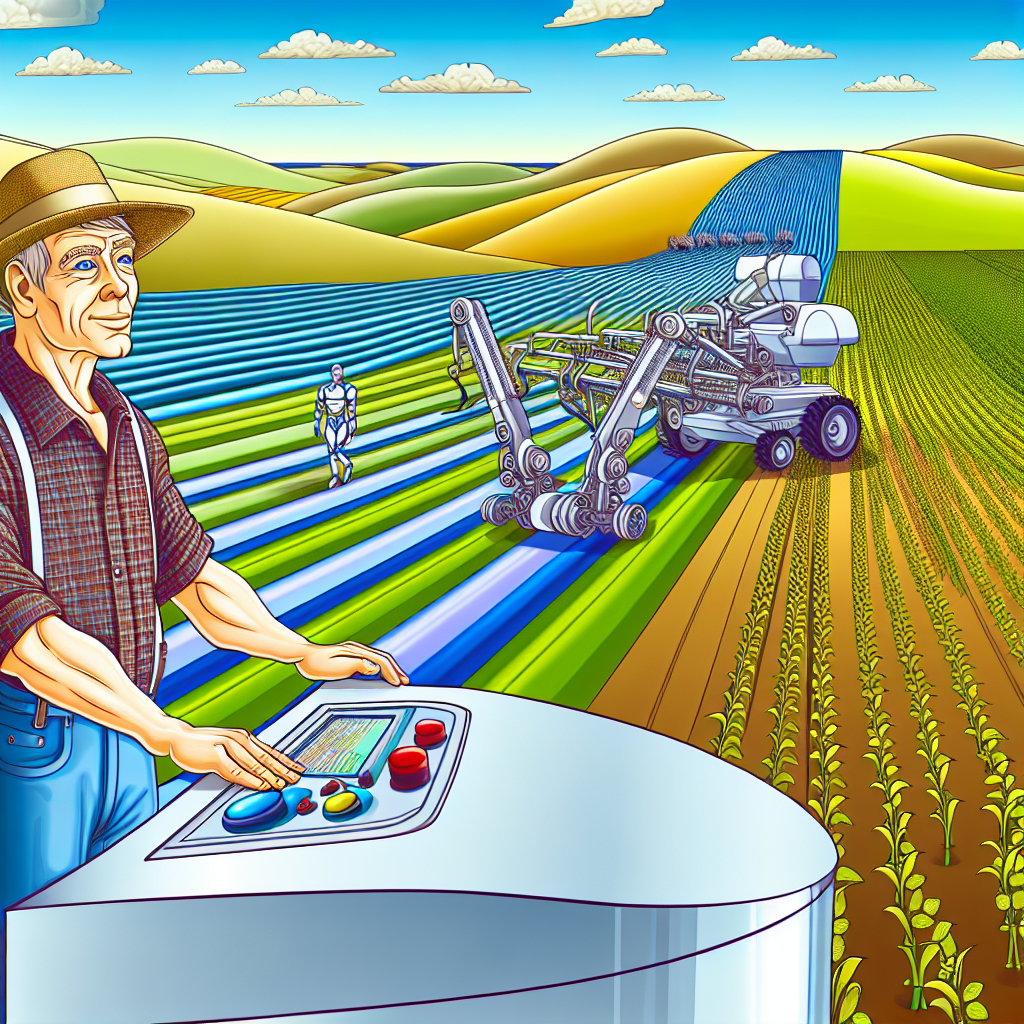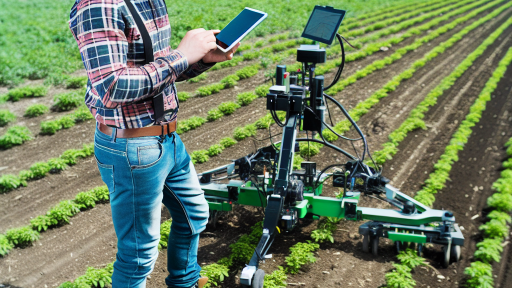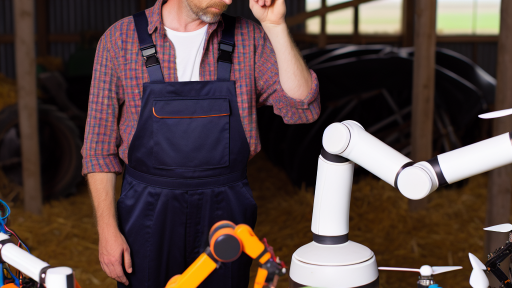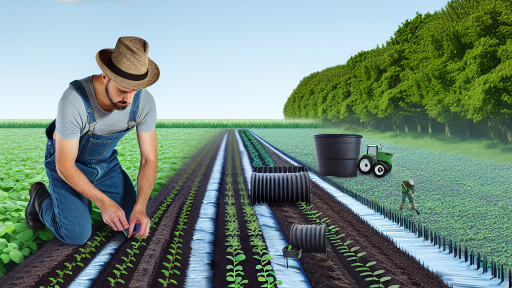Overview of Robotic Innovations in Agriculture
Robotic innovations significantly transform the agricultural landscape.
These technologies enhance productivity and efficiency on farms.
Farmers now utilize robotics for various critical tasks.
As a result, they can manage their time more effectively.
Types of Agricultural Robots
Different types of robots serve various agricultural functions.
Autonomous tractors revolutionize land preparation and planting.
Innovation in harvesting also boosts efficiency.
For example, robotic harvesters operate with precision.
Similarly, drones support crop monitoring and field analysis.
Additionally, robotic milking systems streamline dairy operations.
Benefits of Robotics in Farming
Robots increase operational efficiency by minimizing human labor.
They enhance accuracy in tasks like planting and weeding.
Moreover, robotics reduce operational costs over time.
Automation allows farmers to focus on strategic planning.
Furthermore, robots help mitigate labor shortages in agriculture.
Transform Your Agribusiness
Unlock your farm's potential with expert advice tailored to your needs. Get actionable steps that drive real results.
Get StartedChallenges and Considerations
Integrating robotics into agriculture presents challenges.
Cost is a major barrier for many farmers.
Additionally, there is a need for proper training on new technologies.
Farmers must also consider maintenance and repair issues.
However, many see the long-term benefits outweighing these obstacles.
Industry Trends and Future Innovations
The agricultural robotics market continues to grow rapidly.
Advancements in artificial intelligence drive further innovation.
Smart farming techniques are becoming increasingly popular.
These techniques leverage robotics for precision agriculture.
Looking ahead, we can expect even more sophisticated solutions.
Types of Agricultural Robots
Autonomous Tractors
Autonomous tractors are revolutionizing farm operations.
They perform tasks with minimal human intervention.
Farmers can now focus on strategic decision-making.
These tractors utilize GPS technology for precision.
They enhance efficiency in planting, tilling, and harvesting.
Furthermore, they reduce labor costs significantly.
Leading companies like Agrobotics are innovating in this space.
Drones
Drones are becoming vital tools in modern agriculture.
They assist in crop monitoring and analysis.
Aerial imagery allows farmers to detect issues early.
Drones provide detailed data on plant health and soil conditions.
Additionally, they facilitate targeted spraying of pesticides.
Companies like SkyFarm Tech are at the forefront of this technology.
Robotic Harvesters
Robotic harvesters optimize the fruit-picking process.
Showcase Your Farming Business
Publish your professional farming services profile on our blog for a one-time fee of $200 and reach a dedicated audience of farmers and agribusiness owners.
Publish Your ProfileThey increase harvest speed and reduce waste.
Advanced sensors help them identify ripe produce.
These machines adapt to various crop types and conditions.
Notably, companies like AgriRobot Technologies are leading innovations.
Weeding Robots
Weeding robots are changing traditional methods of pest control.
They identify and remove weeds without harming crops.
This targeted approach minimizes chemical usage.
Reducing herbicide dependency boosts environmental sustainability.
Firms like EcoWeed Solutions are making strides in this area.
Livestock Management Robots
Livestock management robots enhance the oversight of farms.
They monitor animal health and productivity continuously.
These robots provide real-time data to farmers.
This leads to improved decision-making regarding animal care.
Companies like SmartHerd Robotics are pioneering this technology.
Benefits of Agricultural Robotics
Overall, agricultural robots improve productivity dramatically.
They enable more efficient use of resources.
Moreover, they help farmers manage time more effectively.
These innovations contribute to sustainable farming practices.
As technology evolves, the future of farming looks bright.
Impact of Robotics on Crop Management and Yield Optimization
Introduction to Robotic Applications in Agriculture
Robotics transforms traditional farming practices significantly.
Farmers embrace robotic solutions to enhance productivity.
These innovations drive efficiency across various agricultural sectors.
Furthermore, advanced systems integrate with existing workflows smoothly.
Automated Crop Monitoring
Robots equipped with sensors monitor crops accurately.
They assess health and growth conditions effectively.
Data collected aids in decision-making processes for farmers.
Additionally, these systems reduce manual labor efforts.
Farmers can focus on more critical tasks with automation support.
Precision Agriculture Techniques
Robotics enable precision agriculture practices widely.
Farmers apply resources more efficiently using data-driven insights.
For instance, drones assist in targeted spraying of fertilizers.
This method minimizes waste and optimizes resource usage.
Moreover, robotic systems enhance yield forecasting accuracy.
Crop Harvesting Innovations
Robotic harvesters streamline the harvesting process remarkably.
These machines operate around the clock without fatigue.
They efficiently gather crops, reducing spoilage rates.
Consequently, farmers can maximize profits and reduce costs.
In addition, the implementation of robotics improves harvest timing.
Challenges and Considerations
Despite advantages, robotic adoption faces challenges.
Initial investment costs can be substantial for farmers.
Showcase Your Farming Business
Publish your professional farming services profile on our blog for a one-time fee of $200 and reach a dedicated audience of farmers and agribusiness owners.
Publish Your ProfileFurthermore, maintaining and repairing robotic systems requires expertise.
Farmers must weigh these factors against potential benefits.
Continuous education and training remain essential for success.
Future Prospects of Robotic Agriculture
The future of agriculture lies in advanced robotic technology.
Innovations will continue to evolve, enhancing capabilities.
Integration of AI will further increase the effectiveness of robots.
As a result, farmers can expect improved yields and crop quality.
Robotics holds the key to sustainable farming practices.
Find Out More: Sustainable Vertical Farming Operations for Modern Farms
Case Studies: Successful Implementation of Robotics in Farming
Automated Harvesting with AgriTech Solutions
AgriTech Solutions implemented robotic harvesters in apple orchards.
These machines increased the speed of harvesting significantly.
Farmers reported a 30% reduction in labor costs.
Additionally, the harvested apples experienced less damage.
Overall, AgriTech’s robots enhanced efficiency and crop quality.
Drones for Precision Agriculture
GreenField Farms adopted drones for crop monitoring and analysis.
The drones collect data about crops more efficiently than before.
This information helps farmers identify areas needing attention.
Consequently, farmers can apply fertilizers and pesticides precisely.
As a result, GreenField observed up to a 20% increase in yields.
Robotic Milking Systems at Dairy Farms
Clover Dairy introduced robotic milking systems in their operations.
The robots optimize the milking process by scheduling efficiently.
Farmers save time, allowing them to focus on other tasks.
Moreover, the cows experience less stress during milking sessions.
Data analytics also provide insights into cow health and productivity.
Weeding Robots in Organic Farming
EcoFarm deployed weeding robots to manage weed growth in fields.
These robots use cameras and artificial intelligence for precise weeding.
This method reduced the need for chemical herbicides significantly.
Consequently, EcoFarm can maintain organic certification easily.
Furthermore, this solution improved overall crop health and yield.
You Might Also Like: Comparing Traditional and Smart Irrigation Methods
Cost-Benefit Analysis of Adopting Robotics on Farms
Introduction to Cost-Benefit Analysis
Cost-benefit analysis evaluates the financial viability of adopting robotics on farms.
This process involves comparing the costs of implementing robotics against the potential benefits.
Farmers must consider short-term and long-term impacts during this evaluation.
Understanding the Costs
Initial investment in robotics can be substantial for farmers.
Expenses may include purchasing equipment, installation, and training staff.
Maintenance and operational costs also contribute to overall expenses.
Farmers must plan for these costs in their budgets accordingly.
Identifying the Benefits
Robotics significantly enhances farm efficiency and productivity.
These technologies can reduce labor costs over time.
Farmers often see improved crop yields due to more precise operations.
Showcase Your Farming Business
Publish your professional farming services profile on our blog for a one-time fee of $200 and reach a dedicated audience of farmers and agribusiness owners.
Publish Your ProfileAdditionally, automation minimizes human error in various tasks.
Long-Term Financial Gains
Investing in robotics leads to long-term financial gains for farmers.
Increased efficiency translates to higher profit margins.
This can allow farms to scale operations and expand their markets.
Robotics also promotes sustainability, leading to lower overall operational costs.
Case Studies and Real-World Examples
Many farms have successfully implemented robotic systems.
Green Valley Farm uses robotic milking systems to streamline dairy production.
This farm reported a 20% increase in milk output after installation.
Similarly, EcoHarvest incorporates drones for crop monitoring and analysis.
As a result, they optimized their planting strategies and reduced waste.
Determining Return on Investment
Calculating return on investment (ROI) is crucial for farmers.
Farmers should identify how quickly they can expect to recoup costs.
Monitoring performance metrics post-adoption is essential for this analysis.
Adopting robotics can lead to lower costs and increased revenue over time.
Implications of Adopting Robotics in Farming
Adopting robotics on farms presents clear financial advantages.
However, each farm must assess its specific needs and capacities.
The decision should align with both financial goals and operational requirements.
Explore Further: Cost-Effective Sensor Solutions for Agriculture

Future Trends in Agricultural Robotics and Technology Developments
The Rise of Autonomous Farming Equipment
Autonomous farming equipment revolutionizes traditional agricultural practices.
Farmers increasingly adopt drones to monitor crop health.
Robots now handle planting, weeding, and harvesting tasks.
These advancements lead to reduced labor costs and increased efficiency.
Moreover, autonomous tractors can work around the clock.
Integration of AI and Machine Learning
Artificial intelligence (AI) enhances decision-making in agriculture.
Machine learning algorithms analyze vast amounts of data.
Farmers can predict weather patterns and market trends accurately.
This capability allows for more strategic planting and harvesting decisions.
Additionally, AI can optimize resource usage, reducing waste.
Advancements in Precision Agriculture
Precision agriculture technologies provide detailed insights into farming operations.
Sensors and GPS technology enable real-time monitoring of crops.
This data helps in managing inputs like water and fertilizers efficiently.
Consequently, farmers boost yields while minimizing environmental impact.
Furthermore, these practices contribute to sustainable farming efforts.
Collaboration with AgriTech Startups
Established companies collaborate with innovative AgriTech startups.
This collaboration fosters the development of cutting-edge agricultural technologies.
Investment in startups leads to breakthroughs in robotics and automation.
Many startups focus on eco-friendly solutions for modern farming.
Ultimately, these partnerships drive industry-wide advancements and growth.
Emphasis on Sustainability and Eco-Friendly Practices
Sustainable practices are increasingly central to agricultural technology development.
Robotic innovations promote reduced chemical usage in farming.
Showcase Your Farming Business
Publish your professional farming services profile on our blog for a one-time fee of $200 and reach a dedicated audience of farmers and agribusiness owners.
Publish Your ProfileSuch technologies aim to enhance biodiversity and soil health.
Farmers prioritize sustainability to meet consumer demand for eco-friendly products.
Ultimately, these trends lead to a more resilient agricultural sector.
Uncover the Details: Maximizing Profits with Agricultural Data
Challenges in Integrating Robotics into Traditional Farming Practices
Resistance to Change
Farmers often resist adopting new technologies.
This resistance stems from familiarity with existing practices.
Moreover, many farmers doubt the reliability of robotic systems.
They worry that robots may not perform as expected.
This skepticism can hinder innovation in agricultural methods.
High Initial Costs
Investing in robotics can be expensive for farms.
Many farmers operate on tight budgets.
Initial expenses include purchasing and maintaining equipment.
In addition, training staff to use new technology requires resources.
This financial burden can discourage adoption of robotic solutions.
Technical Challenges
Integrating robotics into existing farm systems proves complex.
Farms often have unique layouts and workflows.
Adaptation may require significant modifications to processes.
Furthermore, ensuring compatibility between devices can complicate implementation.
This technical complexity presents a barrier to entry for many farmers.
Lack of Technical Support
Farmers need access to technical support for robotic systems.
However, many rural areas lack trained personnel.
This shortage leads to frustration when issues arise.
Farmers may feel abandoned without immediate assistance.
Ultimately, this issue can result in underutilization of technology.
Uncertain Return on Investment
Many farmers question the economic viability of robotics.
They often assess potential benefits against investment costs.
This uncertainty can lead to hesitance in adopting new technologies.
Many prioritize immediate financial returns over long-term gains.
Consequently, some farmers overlook the potential advantages robotics offer.
The Role of Data Analytics and AI in Enhancing Robotic Efficiency
Understanding Data Analytics in Agriculture
Data analytics plays a crucial role in modern farming.
It allows farmers to analyze vast amounts of data efficiently.
Consequently, they can make informed decisions about crop management.
Furthermore, analytics helps in predicting crop yields accurately.
As a result, farmers can optimize their resources effectively.
Integrating AI into Farming Practices
Artificial Intelligence significantly boosts agricultural productivity.
Agricultural robots equipped with AI can assess field conditions in real-time.
Moreover, these robots can identify pests or diseases quickly.
This capability enables timely interventions to protect crops.
Additionally, AI can automate tasks like planting and harvesting.
Enhancing Decision-Making with Predictive Analytics
Predictive analytics empowers farmers to foresee potential challenges.
Showcase Your Farming Business
Publish your professional farming services profile on our blog for a one-time fee of $200 and reach a dedicated audience of farmers and agribusiness owners.
Publish Your ProfileFarmers can anticipate weather changes and market demands.
Consequently, they can adapt their strategies accordingly.
This foresight minimizes risks and maximizes profits.
Both data and AI enhance the accuracy of these predictions.
Improving Efficiency through Automation
Automation streamlines various farming processes.
Robotic systems can perform labor-intensive tasks with precision.
As a result, farmers save time and reduce operational costs.
Moreover, robots operate tirelessly, leading to increased output.
Ultimately, this efficiency helps in meeting food production demands.
Future Trends in Agricultural Robotics
The future of agricultural robotics looks promising.
Innovations in machine learning are enhancing robotic capabilities.
For instance, systems can learn from environmental data.
This adaptability leads to continuous improvements in farming practices.
Moreover, integration with IoT devices will further enhance efficiency.
Additional Resources
Application of digital technologies for ensuring agricultural productivity




